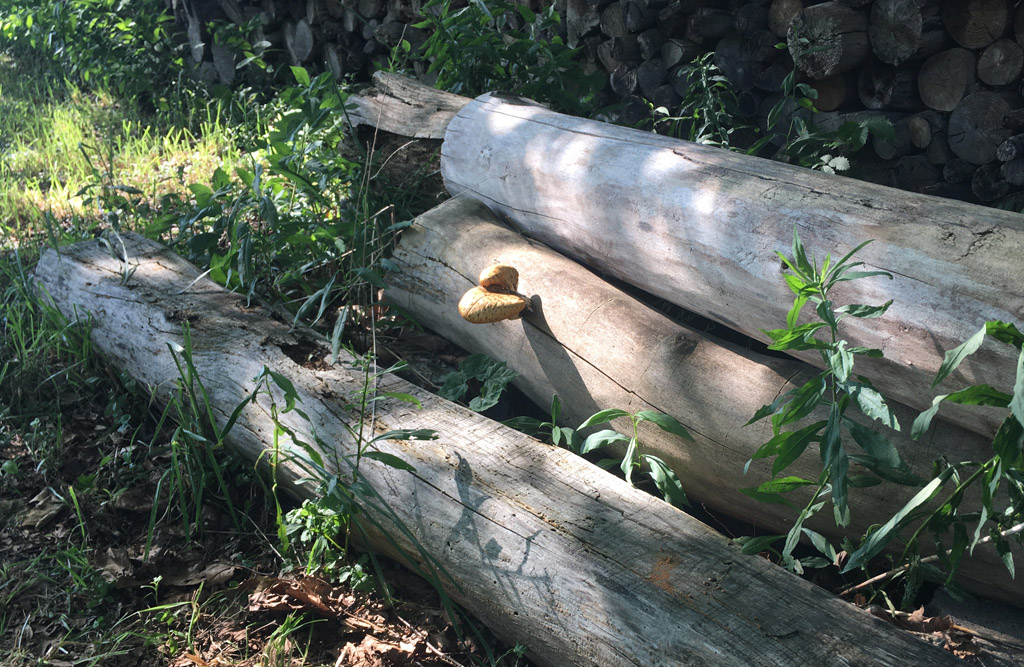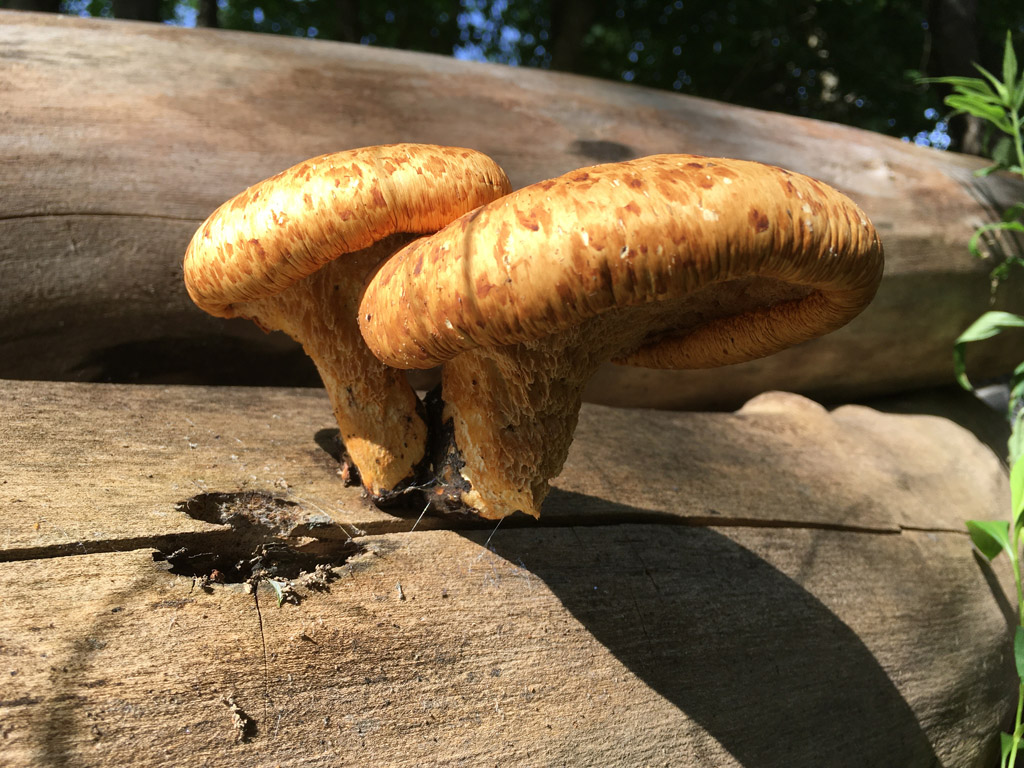Late one summer afternoon, an angled evening sun had finally peeked below persistent clouds, as if it had a sudden whim to brighten what it might. Unopposed, it spilled and tripped across my cluttered yard, raising all in high relief, splashing all it struck in shades of gold — every surface standing proud, sporting sharp-edged shadows smartly cut from a bolt of black.
An idle glance across the kitchen sink led my eye to a glowing sight: some thing that wasn’t there a day before — or wasn’t colored quite so garishly — had loudly claimed a spot upon a fallen, greying log.
I dried my hands and went to take a look.
For several years a pair of logs had weathered in this spot, neglected since I last assessed a plan to build a bench. Rushing in to fill this void was a pair of speckled mushroom-caps, bursting forth from their woody inner realm, to bask for a time in the airy world of light.

My best guess is that this is a specimen of Polyporus squamosus, also known by the more romantic name of “Dryad’s Saddle.” This is a marginally edible wood mushroom that feeds on dead and dying hardwoods. As we see here, it is not so particular as to shrink from a suitable host, even if it emerges to find itself in a partially shaded lawn instead of a forest. This is a mature example, probably well past its sell-by date, adorning the horizonal trunk of a long-dead Ash.

As if to please the humble mushroom-hunter, it also carries the more prosaically descriptive name of “Pheasant-back mushroom,” a reference to its speckled pattern. But on learning of its other, more commonly cited name, I was led to wonder who, encountering this arresting sight in a lonely wood of long ago, was moved instead to think of dryads — the fairy nymphs whom the poets of ancient Greece assigned to inhabit the forest trees. Classical influences are often seen in Latin names, but not in common ones — which are typically assigned not by scientists, but through tradition by the common folk, who are less likely to draw from a classical education when naming and talking about their favorite finds.
In the name “dryad’s saddle,” saddle refers to a seat or resting place. The concept, then, is that these mushrooms provide a convenient place for a dryad to sit and rest, between frolics perhaps. This one, in fact, looks particularly comfortable — above the seat, is that a dryad’s armrest?

Perhaps it was through a scene from a popular play, or through a habit of childrens-book illustrators, that the image of dryads resting on mushroom caps became familiar to a popular consciousness of long ago. But the association of anthropomorphic spirits with things of mystery and wonder is a long-held human tradition. As William Blake wrote,
“The ancient Poets animated all sensible objects with Gods or Geniuses, calling them by the names and adorning them with the properties of woods, rivers, mountains, lakes, cities, nations, and whatever their enlarged & numerous senses could perceive.”
We might add mushrooms to the mix.
On a winsome summer evening, I am happy to entertain the existence of dryads in the woods. Perhaps that is the most satisfying explanation for those things we feel in full, but which frustrate our attempts to describe them adequately — such as the intoxicating, intangible essence of the fall of a summer’s evening. What other single notion could at once embody the trills and throaty croaks, the trailing flares of yellow-green, the scents that rise from the dewing grass, that attend the surrender of day to night? These spirits haunt the eventide, patrolling the boundary of dark and light, and can work a magic powerful enough to conjure our earliest and sweetest memories — those that even our infant minds innately knew to keep.
“Out of this wood do not desire to go;
– Titania, “A Midsummer Night’s Dream” (Act 3, Scene 1)
Thou shalt remain here, whether thou wilt or no.
I am a spirit of no common rate;
The summer still doth tend upon my state;
And I do love thee.”
In today’s world, one might say that harboring an unnatural interest in the natural is a form of enchantment. So who should stoop to ponder a fallen log, yet doubt that dryads live? It is as good to imagine that the spirit that knew this barkless ash, now sawed in half and bent to a mortal’s fickle will, has appropriated my unbuilt bench in her quest for a fitting throne.
Among diverted plans, what better fate, that now here sits a nymph instead of me?
Article and images Copyright 2022 by the author.
To be notified of new articles, visit https://whatshallweweird.com/subscribe/


